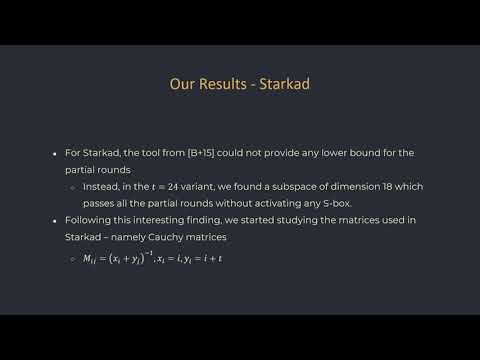CryptoDB
Mind the Middle Layer: The HADES Design Strategy Revisited
| Authors: |
|
|---|---|
| Download: |
|
| Conference: | EUROCRYPT 2021 |
| Abstract: | The HADES design strategy combines the classical SPN construction with the Partial SPN (PSPN) construction, in which at every encryption round, the non-linear layer is applied to only a part of the state. In a HADES design, a middle layer that consists of PSPN rounds is surrounded by outer layers of SPN rounds. The security arguments of HADES with respect to statistical attacks use only the SPN rounds, disregarding the PSPN rounds. This allows the designers to not pose any restriction on the MDS matrix used as the linear mixing operation. In this paper we show that the choice of the MDS matrix significantly affects the security level provided by HADES designs. If the MDS is chosen properly, then the security level of the scheme against differential and linear attacks is significantly higher than claimed by the designers. On the other hand, weaker choices of the MDS allow for extremely large invariant subspaces that pass the entire middle layer without activating any non-linear operation (a.k.a. S-box). We showcase our results on the Starkad and Poseidon instantiations of HADES. For Poseidon, we significantly improve the lower bounds on the number of active S-boxes with respect to both differential and linear cryptanalysis provided by the designers – for example, from 28 to 60 active S-boxes for the t = 6 variant. For Starkad, we show that for any variant with t (i.e., the number of S-boxes in each round) divisible by 4, the cipher admits a huge invariant subspace that passes any number of PSPN rounds without activating any S-box (e.g., a subspace of size 2^1134 for the t = 24 variant). Furthermore, for various choices of the parameters, this invariant subspace can be used to mount a preimage attack on the hash function that breakes its security claims. On the other hand, we show that the problem can be fixed easily by replacing t with any value that is not divisible by four. Following our paper, the designers of Starkad and Poseidon amended their design, by adding requirements which ensure that the MDS matrix is chosen properly. |
Video from EUROCRYPT 2021
BibTeX
@inproceedings{eurocrypt-2021-30911,
title={Mind the Middle Layer: The HADES Design Strategy Revisited},
publisher={Springer-Verlag},
doi={10.1007/978-3-030-77886-6_2},
author={Nathan Keller and Asaf Rosemarin},
year=2021
}

